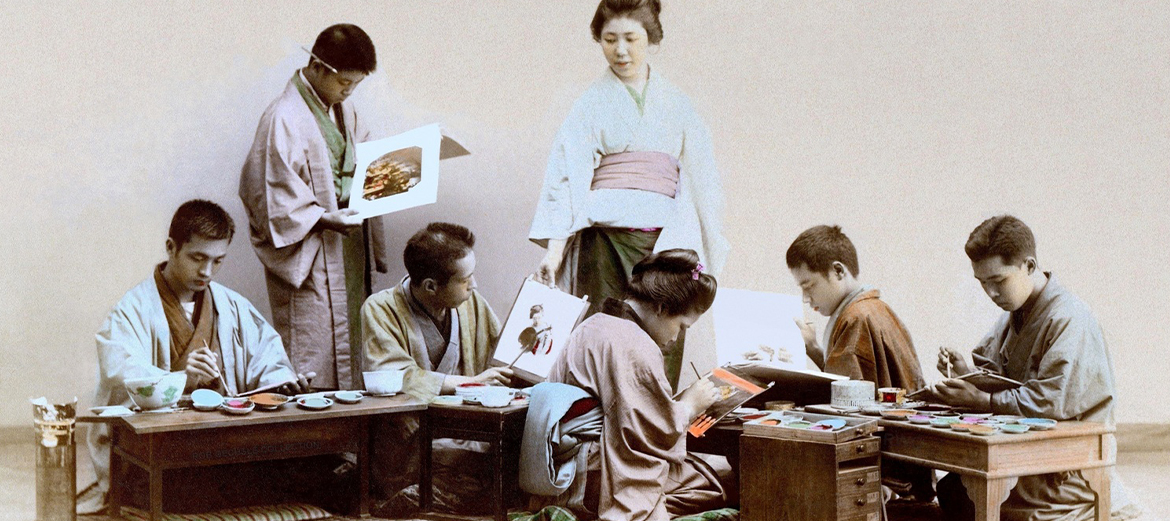
In 2017, the idea for Behind the Camera was sparked with a simple question: what resources existed on the roles that women have played in the history of Japanese photography? Since the introduction of the first camera to Japan in 1848, women have been integral to the social constructions of photography as a visual technology, art form, and commercial practice.
| The earliest known photograph to have been taken by a Japanese woman dates to 1864; in 1929, Yamazawa Eiko was the first woman to open a photography studio; in the 1940s Sasamoto Tsuneko produced propaganda for the wartime state as the self-proclaimed “first female photojournalist” in Japan; and, in the postwar period, women entered the fields of photojournalism, fashion, and studio photography in the largest numbers to date. Yet, there is no coherent history of women photographers in Japanese or English. While the Tokyo Photographic Art Museum opened in 1990, it did not have its first solo exhibition of a woman photographer until Ishiuchi Miyako’s Mother’s show in 2006.
Women photographers require a history that intersects social and political history with the close analysis of their work and its implications for visual culture in Japan. Beyond accounting for historical omissions, we sought ways to interrogate the overwhelmingly male-centered historiography of Japanese photography and to address the ideologies that have consistently |
reinstated gendered hierarchies within the photography world. We knew that these efforts could not be individual but would require a collaborative, multidisciplinary approach. As Victoria Horne and Amy Tobin write in “an unfinished revolution in art historiography, or how to write a feminist art history” (2014): “We know that collectivizing knowledge production can destabilize the belief in a singular, objective authority and offer instead politically situated examinations of the past, but it also (crucially) allows us to disrupt our own assumptions by staging an encounter between various voices and positions.”
To that end, in 2019, we brought together a multidisciplinary group of scholars from Japan, the United States, the United Kingdom, and Israel for a two-part panel at the Association of Asian Studies (AAS) Annual Conference. Sponsored by the Japan Art History Forum, the panelists identified key questions that continue to inform our work: |
|
|
| The conversations generated at AAS made clear that the histories of Japanese women in photography required a sustained platform that would allow research to develop organically and collaboratively. During the Covid-19 pandemic, the project transformed into a website where specialists | share carefully researched arguments and source materials made available to the public in both English and Japanese. In times when travel to archives and conferences is difficult, this website seeks to bring photographs, scholarly perspectives, and historical resources directly to you. |
2017年、Behind the Camera (カメラの後ろで) は、「日本の写真史で女性が担ってきた多様な役割について、どのような資料が存在するのか」という素朴な疑問から着想を得ました。1848年に日本に初めてカメラが輸入されて以来、視覚技術、芸術様式、商業活動を通して、女性は写真の社会的構築に不可欠な存在であり続けました。日本人女性が撮った最も古い写真は1864年のものとされており、1929年には山沢栄子が女性で初めて写真スタジオを開設し、1940年代には笹本恒子が日本で「最初の女性フォトジャーナリスト」を自称して戦時中の国家プロパガンダを目的とした作品を制作し、戦後から今日まで、フォトジャーナリズム、ファッション、スタジオ写真の分野に数多くの女性が参入しています。しかし、日本語でも英語でも、女性写真家に関するまとまった歴史の記述はありません。東京写真美術館は1990年に開館しましたが、女性写真家の個展は2006年の石内都の「Mother’s」展まで開催されませんでした。
女性写真家の歴史を語るには、社会史や政治史を交差させながら、彼女たちの作品が日本の視覚文化にどのような意味を持ったのかを綿密に分析していく必要があります。私たちは、歴史における女性写真家の記述の欠如を補うだけでなく、圧倒的に男性中心で進めてきた日本写真のヒストリオグラフィそのものに疑問を投げかけ、写真界にジェンダーの権力構造を絶え間なく再生産してきたイデオロギーに批判的に取り組む方法を模索しました。 個人でこのような仕事を成し遂げることは難しく、協働的かつ学際的アプローチが必要です。ヴィクトリア・ホーンとエイミー・トビンは『美術史学における未完の革命、あるいはフェミニスト美術史の書き方』(2014)の中でこのように書いています:「私たちは、知識の生産様式を集団化することで、単一的、客観的権威への信仰を揺るがし、代わりに特定の政治的立ち位置から過去の検証をすることができると知っています。しかしそれはまた(極めて重要なことに)、様々な意見と立場の邂逅を実現することによって、私たち自身の憶測を攪乱することをも可能にするのです」
そのような新しい美術史を目指し、2019年には、日本美術史フォーラムの支援を受け、日本、アメリカ、イギリス、イスラエルのさまざまな学問分野から研究者を集め、アジア研究協会(AAS)年次学会において2部構成のパネルディスカッションを開催しました。そこでパネリストたちが提示した以下の問題意識が、本プロジェクトに重要な方向性を示しました。
- 写真史の研究は、フェミニズム研究に何をもたらすのか。
- 女性たちは、男性優位のイメージ作りの世界で、どのようにそれを渡り歩き、それと争い、それに挑戦しているか。
- 写真家のアイデンティティと作品において、ジェンダー、セクシュアリティ、人種、階級、個人的な経験は、いつ、どのように関わってくるか。
- これらの歴史を書く上で、私たちが直面する限界は何か。
- そして、グローバルなフェミニズム史へのアプローチを拡大しながら、日本の女性写真家の歴史を書くために、どのような方法が可能か。
AASでの討論を通じて、日本の女性写真家の歴史研究には、有機的かつ協働的に研究を進めていくことを可能とさせる持続的なプラットフォームが必要であることが明らかになりました。コロナ禍で、このプロジェクトは、専門家が入念に調査した議論や資料を日英の両言語で公開するウェブサイトへと変貌を遂げました。資料館や学会に足を運ぶことが困難な時代だからこそ、ここでは写真や学術的な視点、歴史資料に直接アクセス可能にすることを目指しました。
| Made possible by the Social Sciences and Humanities Research Council of Canada, the University of British Columbia, and the International Joint Digital Archiving Center for Japanese Art and Culture (ARC-iJAC), Art Research Center, Ritsumeikan University. |  |